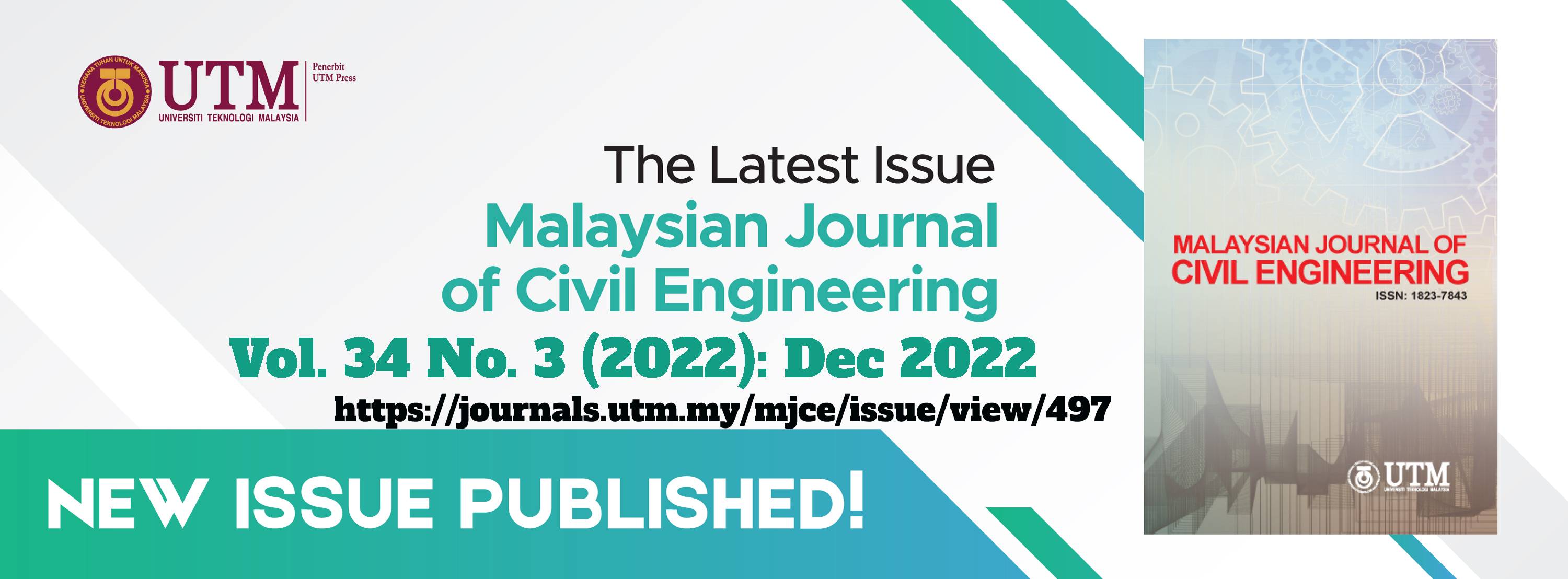NLFEM WITH HIGHER ORDER INTERPOLATION FUNCTION FOR EFFICIENT ANALYSIS OF IRREGULAR DOMAIN
DOI:
https://doi.org/10.11113/mjce.v34.18529Keywords:
FEM, NAFEM, NURBS, Lagrange interpolation function, Irregular domainAbstract
This study proposes a new approach to developing a more efficient numerical technique by coupling the non-uniform rational B-spline (NURBS) with the higher-order polynomial basis functions under the framework of the Finite Element Method (FEM). In this technique, denoted as NURBS-Lagrange FEM (NLFEM), the NURBS basis functions are employed to represent the geometry of the problem domain, while the Lagrange interpolation functions are employed for the higher-order polynomial functions to interpolate the field variables. The NURBS is a mathematical model which provides a numerically stable algorithm to exactly represent all conic sections, and the Lagrange interpolation function allows for higher-order basis functions resulting in a faster convergence rate of analysis. By taking advantage of both models, the objective of this study is to propose a new approach, i.e., NLFEM, which can improve the accuracy of the analysis of the irregular domain with more efficient consumption of computer resources. A steady heat transfer formulation for a curved boundary problem is presented to demonstrate the validity and accuracy of the developed technique. The performance is verified against converged solutions obtained using higher-order FEM (FEM/Q9) and NURBS-Augmented FEM (NAFEM). The presented result shows that the NLFEM provides a favorable comparison against other methods. The converged solution is achieved 20% faster than the FEM/Q9 and 80 % faster than the NAFEM. This highlights the potential of the NLFEM as a new approach in numerical techniques for solving problems with irregular boundaries.
References
Agrawal, V., & Gautam, S. S. 2019. IGA: a simplified introduction and implementation details for finite element users. Journal of The Institution of Engineers (India): Series C, 100(3): 561-585.
Bazilevs, Y., Beirao, L., Veiga, D., Cottrell, J., Hughes T.J.R., and Sangalli, G. 2006. Isogeometric analysis: approximation, stability and error estimates for h-refined meshes. Mathematical Models and Methods in Applied Sciences, 16: 1031-1090.
Chi, S. W., & Lin, S. P. 2016. Meshfree analysis with the aid of NURBS boundary. Computational Mechanics, 58(3): 371-389.
Cottrell, J.A., Hughes, T.J.R. and Bazilevs, Y. 2009 Isogeometric analysis toward integration of CAD and FEA. John Wiley and Sons.
Cottrell, J.A., Reali, A., Bazilevs, Y. and Hughes, T.J.R. 2006. Isogeometric analysis of structural vibrations. Computer Methods in Applied Mechanics and Engineering, 195: 5257-5296.
De Lazzari, E., van den Boom, S. J., Zhang, J., van Keulen, F., & Aragón, A. M. 2021. A critical view on the use of Non‐Uniform Rational B‐Splines to improve geometry representation in enriched finite element methods. International Journal for Numerical Methods in Engineering, 122(5): 1195-1216.
Greco, F., Coox, L., & Desmet, W. 2016. Maximum-entropy methods for time-harmonic acoustics. Computer Methods in Applied Mechanics and Engineering, 306: 1-18.
Greco, F., Coox, L., Maurin, F. and Desmet, W. 2017. NURBS-enhanced maximum-entropy schemes. Computer Methods in Applied Mechanics and Engineering, 317: 580–97.
Heinrich, C., & Simeon, B. 2012. A finite volume method on NURBS geometries and its application in isogeometric fluid–structure interaction. Mathematics and Computers in Simulation, 82(9): 1645-1666.
Hughes, T.J.R., Cottrell, J.A., and Bazilevs, Y. 2005. Isogeometric analysis: CAD, finite elements, NURBS, exact geometry and mesh refinement. Computer Methods In Applied Mechanics And Engineering 194: 4135–4195.
Legrain, G. 2013. A NURBS enhanced extended finite element approach for unfitted CAD analysis. Computational Mechanics, 52(4): 913-929.
Lu, J., Yang, G., & Ge, J. 2013. Blending NURBS and Lagrangian representations in isogeometric analysis. Computer Methods in Applied Mechanics and Engineering, 257: 117-125.
Make, M., Hosters, N., Behr, M., & Elgeti, S. 2020. Space-Time NURBS-Enhanced Finite Elements for Solving the Compressible Navier–Stokes Equations. In Numerical Methods for Flows. 97-107.
Meng, X., & Hu, G. 2018. A NURBS-enhanced finite volume solver for steady Euler equations. Journal of Computational Physics, 359: 77-92.
Mishra, B. P., and Barik, M. 2018. NURBS‑augmented finite element method for stability analysis of arbitrary thin plates. Engineering with Computers., 35(38):1-12.
Mishra, B. P., and Barik, M. 2020. NURBS-Augmented Finite Element Method for static analysis of arbitrary plates. Computers and Structures., 232.
Mishra, B. P., & Barik, M. 2021. Free flexural vibration of thin stiffened plates using NURBS-Augmented finite element method. In Structures 33: 1620-1632.
Mokhtaram, M. H., Mohd Noor, M. A., Jamil Abd Nazir, M. Z., Zainal Abidin, A. R., and Mohd Yassin, A. Y. 2020. Enhanced meshfree RPIM with NURBS basis function for analysis of irregular boundary domain. Malaysian Journal of Civil Engineering 32(1): 19–27.
Nguyen, N. T., Nguyen, M. N., Van Vu, T., Truong, T. T., & Bui, T. Q. 2022. A meshfree model enhanced by NURBS-based Cartesian transformation method for cracks at finite deformation in hyperelastic solids. Engineering Fracture Mechanics, 261: 108176.
Pantaleón, C. (2014). Applications of Isogeometric Analysis Coupled with Finite Volume Method. Rochester Institute of Technology.
Rosolen, A. and Arroyo, M. (2013). Blending isogeometric analysis and local maximum entropy meshfree approximants. Computer Methods in Applied Mechanics and Engineering, 264: 95–107.
Safdari, M., Najafi, A. R., Sottos, N. R., & Geubelle, P. H. 2015. A NURBS‐based interface‐enriched generalized finite element method for problems with complex discontinuous gradient fields. International Journal for Numerical Methods in Engineering, 101(12): 950-964.
Sevilla, R., Fernandez-Mendez, S., & Huerta, A. 2008a. NURBS-enhanced finite element method (NEFEM). International Journal for Numerical Methods in Engineering, 76: 56-83.
Sevilla, R., Fernandez-Mendez, S., & Huerta, A. 2008b. NURBS-enhanced finite element method for Euler equations. International Journal for Numerical Methods in Fluids, 57:1051–1069.
Sevilla, R., Fernández‐Méndez, S., & Huerta, A. 2011. 3D NURBS‐enhanced finite element method (NEFEM). International Journal for Numerical Methods in Engineering, 88(2): 103-125.
Sevilla, R., Rees, L., & Hassan, O. (2016). The generation of triangular meshes for NURBS‐enhanced FEM. International Journal for Numerical Methods in Engineering, 108(8): 941-968.
Wang, Q., Zhou, W., Cheng, Y., Ma, G., Chang, X., & Liu, B. 2019. A NURBS-enhanced improved interpolating boundary element-free method for 2D potential problems and accelerated by fast multipole method. Engineering Analysis with Boundary Elements, 98: 126-136.
















